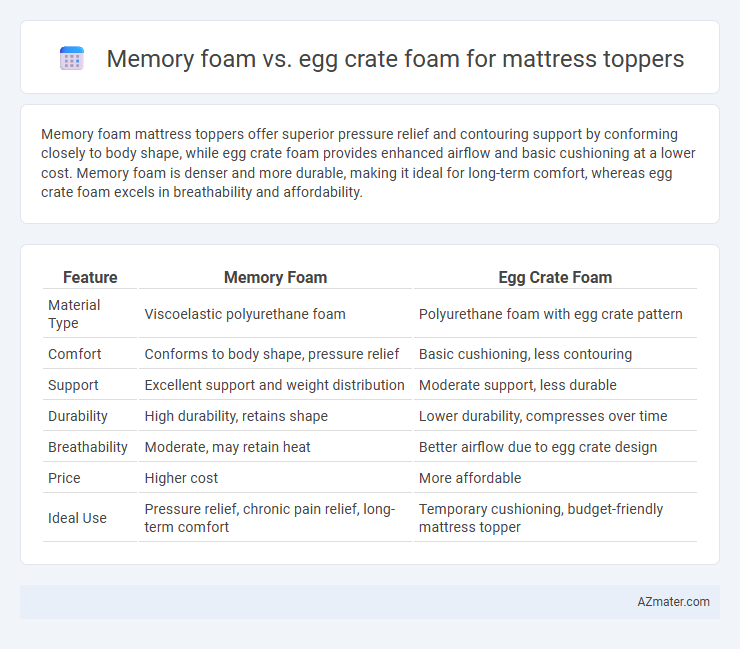Memory foam mattress toppers offer superior pressure relief and contouring support by conforming closely to body shape, while egg crate foam provides enhanced airflow and basic cushioning at a lower cost. Memory foam is denser and more durable, making it ideal for long-term comfort, whereas egg crate foam excels in breathability and affordability.
Table of Comparison
| Feature | Memory Foam | Egg Crate Foam |
|---|---|---|
| Material Type | Viscoelastic polyurethane foam | Polyurethane foam with egg crate pattern |
| Comfort | Conforms to body shape, pressure relief | Basic cushioning, less contouring |
| Support | Excellent support and weight distribution | Moderate support, less durable |
| Durability | High durability, retains shape | Lower durability, compresses over time |
| Breathability | Moderate, may retain heat | Better airflow due to egg crate design |
| Price | Higher cost | More affordable |
| Ideal Use | Pressure relief, chronic pain relief, long-term comfort | Temporary cushioning, budget-friendly mattress topper |
Introduction: Memory Foam vs Egg Crate Foam Mattress Toppers
Memory foam mattress toppers conform to body contours, providing pressure relief and support through viscoelastic properties that reduce motion transfer and improve sleep quality. Egg crate foam toppers feature a convoluted surface that enhances airflow and offers moderate cushioning, making them a budget-friendly option for pressure point alleviation. Comparing density, durability, and temperature regulation helps determine the best choice based on individual comfort and sleeping needs.
Material Composition and Structure Comparison
Memory foam mattress toppers are made from viscoelastic polyurethane, which responds to body heat and pressure by conforming closely to the sleeper's shape, providing targeted support and pressure relief. Egg crate foam toppers consist of convoluted polyurethane foam with a distinctive egg crate pattern that increases airflow and reduces pressure points through its contoured surface. The dense, slow-recovery structure of memory foam contrasts with the lightweight, open-cell design of egg crate foam, affecting durability, breathability, and overall comfort.
Comfort and Pressure Relief Differences
Memory foam mattress toppers contour closely to body shape, providing superior pressure relief by evenly distributing weight and reducing pressure points, making them ideal for individuals with joint pain or sensitive areas. Egg crate foam offers a more basic cushioning effect with its convoluted design, improving airflow and providing moderate comfort but less targeted pressure relief compared to memory foam. The viscoelastic properties of memory foam give it enhanced durability and responsiveness, whereas egg crate foam tends to compress and lose support over time.
Support and Spinal Alignment Effects
Memory foam mattress toppers provide superior support by contouring precisely to body curves, promoting optimal spinal alignment and reducing pressure points. Egg crate foam offers moderate support with its textured surface, which enhances airflow but lacks the personalized contouring needed for effective spinal alignment. For individuals seeking targeted support and improved posture during sleep, memory foam is the preferred choice over egg crate foam.
Temperature Regulation and Breathability
Memory foam mattress toppers offer superior contouring and pressure relief but often retain heat due to their dense structure, leading to reduced breathability and potential discomfort in warmer climates. Egg crate foam features a convoluted surface design that enhances airflow and promotes better temperature regulation by allowing heat to dissipate more effectively, making it a cooler sleeping option. While memory foam excels in support, egg crate foam provides enhanced breathability and cooling, appealing to sleepers who prioritize temperature control.
Durability and Longevity Insights
Memory foam mattress toppers typically offer superior durability compared to egg crate foam due to their higher density and ability to retain shape over time. Egg crate foam, while affordable and lightweight, tends to compress faster and loses support within months of regular use, leading to reduced comfort and lifespan. Choosing high-density memory foam ensures extended longevity and consistent pressure relief for mattress toppers.
Motion Isolation Performance
Memory foam mattress toppers deliver superior motion isolation by contouring closely to the body and absorbing movement, which prevents disturbances from partner shifts during sleep. Egg crate foam provides moderate motion isolation but lacks the dense structure to fully absorb motion transfer, resulting in more noticeable disturbances. For enhanced sleep quality in shared beds, memory foam outperforms egg crate foam in reducing motion transference.
Allergy-Friendliness and Health Considerations
Memory foam mattress toppers are hypoallergenic, resistant to dust mites, and antimicrobial, making them ideal for allergy sufferers and improving overall indoor air quality. Egg crate foam provides some ventilation and pressure relief but tends to trap allergens and lacks antimicrobial properties, posing potential risks for individuals with sensitivities. Users prioritizing allergy-friendliness and health should opt for CertiPUR-US certified memory foam that meets strict standards for low volatile organic compound (VOC) emissions and safe chemical content.
Price and Value for Money
Memory foam mattress toppers typically cost more but offer superior pressure relief, durability, and motion isolation compared to egg crate foam. Egg crate foam is budget-friendly and provides basic cushioning but lacks the contouring and support of memory foam, making it less valuable for long-term use. Choosing memory foam yields better value for money due to enhanced comfort and longevity despite the higher initial price.
Choosing the Best Mattress Topper for Your Sleep Needs
Memory foam mattress toppers contour closely to the body, offering superior pressure relief and motion isolation ideal for individuals with joint pain or side sleepers. Egg crate foam promotes airflow and provides moderate cushioning but lacks the deep support of memory foam, making it better suited for those seeking enhanced ventilation and a budget-friendly option. Selecting the best mattress topper depends on prioritizing pressure relief, support, and breathability based on your unique sleep preferences and pain management requirements.

Infographic: Memory foam vs Egg crate foam for Mattress topper
 azmater.com
azmater.com